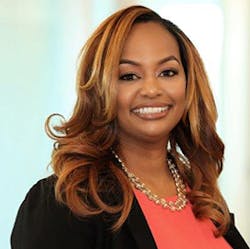“I am personally passionate about fostering great diversity within our company,” said CEO Sanjay Mehrotra in the company’s 2019 Diversity, Equality and Inclusion Report.
“Ideas are the foundation of our business and the best ideas only merge when you create an atmosphere where all voices can be heard,” Mehrotra wrote.
The company explains that its goal is to “honor how our individual backgrounds, experiences, and perspectives create a greater whole.”
“When you are pushing for innovation all ideas need to be on the table,” explains Sharawn Connors, vice president of Diversity, Equality and Inclusion, Micron. “A company should not have any judgments about where the best ideas should come from based on how someone looks, their education or background.”
Part of the company's commitment to this ideal was demonstrated by its second annual Diversity, Equality and Inclusion Week in June at over 27 sites across the globe.
Another way the company is ensuring inclusion is to ironically place people in groups that reflect their similarities. These groups, called Employee Resource Groups (ERG), are employee-led groups that are organized around specific characteristics.
In the past year, ERG membership at Micron grew by 72% and the company now has eight groups.
They are as follows:
Micron Hispanic Professionals
Micron Young Professionals
Pride + Allies
Black Employee Network
Micron Women’s Leadership Network
Veteran’s Employee Resource Group
Tenured and Experienced@Micron
Capable (This group focuses on team members with disabilities or have family members they are supporting with disabilities).
At Micron there is a specific process involved in creating an ERG. To being with an employee will discuss the governance of the group with Connors. or a diversity manager. Next guidelines and a charter must be completed. Then the group needs to appoint an internal leader and find an executive sponsor.
Next comes a review from an advisory board called the Diversity Council. Once approved the group receives assistance with branding, budgeting and communication.
“While the group holds internal activities, they also very active in the communities where our company's facilities are located,” says Connors.
The company has found that in addition to creating spaces for diverse populations to form connections, these groups are a perfect source of new talent for career development.
Furthermore, the existence of these groups has an appeal to potential candidates. “There is an expectation from our potential team members that diversity is a business imperative,” says Connors. “While we fundamentally believe that it’s the right thing to do, we do feel the expectations of diversity, inclusion and equality from our current team members and future candidates.”
Often ERG participants will attend recruiting events. “We hear comments from candidates that when they see someone like themselves they tend to view the company as somewhere they would belong and can envision building a career,” says Connors.
When asked about best practices to creating and incorporating these groups into the company Connors provided some action steps.
Analyze your Workforce – “You might already have these groups at your workplace but they are not recognized as such or in a formal structure."
Get Executive Commitment – “Our CEO meets with these groups on a regular basis."
Review Your Talent Acquisition Strategy – “Take time to look at how you are recruiting and see if you are intentional about your hiring. Ask those outside of HR to look at what you're doing as there is always room for improvement. Don’t accept business as usual and update strategies on an annual basis. ”
Leverage Technology. “There are so many new platforms on the market that support diversity, equality and inclusion. It doesn’t matter the size of your organization as there are platforms for all types.”
Connors says that her work in this area has only just begun. “We want to continue to elevate these groups, widen their platforms and ask them to help us solve business problems. “
About the Author
Adrienne Selko
Sr. Editor
Focus: Workforce, Talent
Email: [email protected]
Follow Me on Twitter: @ASelkoIW
Senior Editor Adrienne Selko has written about many topics over the 17 years she has been with the publication and currently focuses on workforce development strategies. She is also a senior editor at Material Handling & Logistics and EHS Today.
Previously Adrienne was in corporate communications at a medical manufacturing company as well as a large regional bank.
She is the author of Do I Have to Wear Garlic Around My Neck?, which made the Cleveland Plain Dealer's best sellers list.

